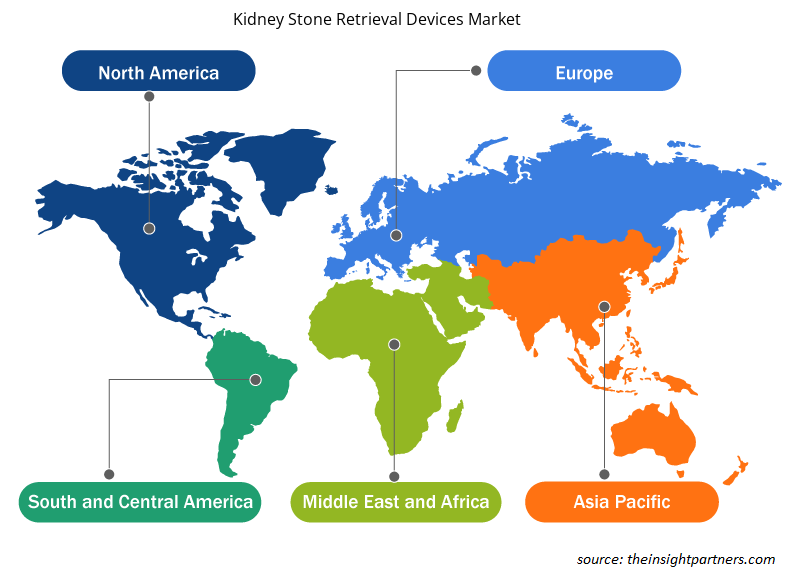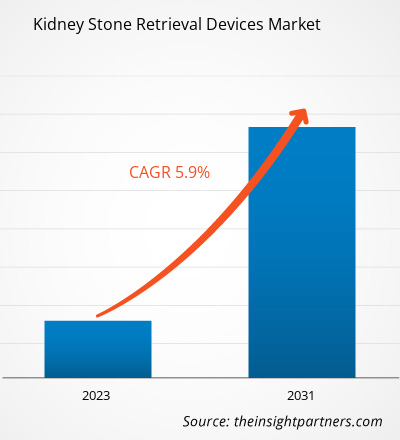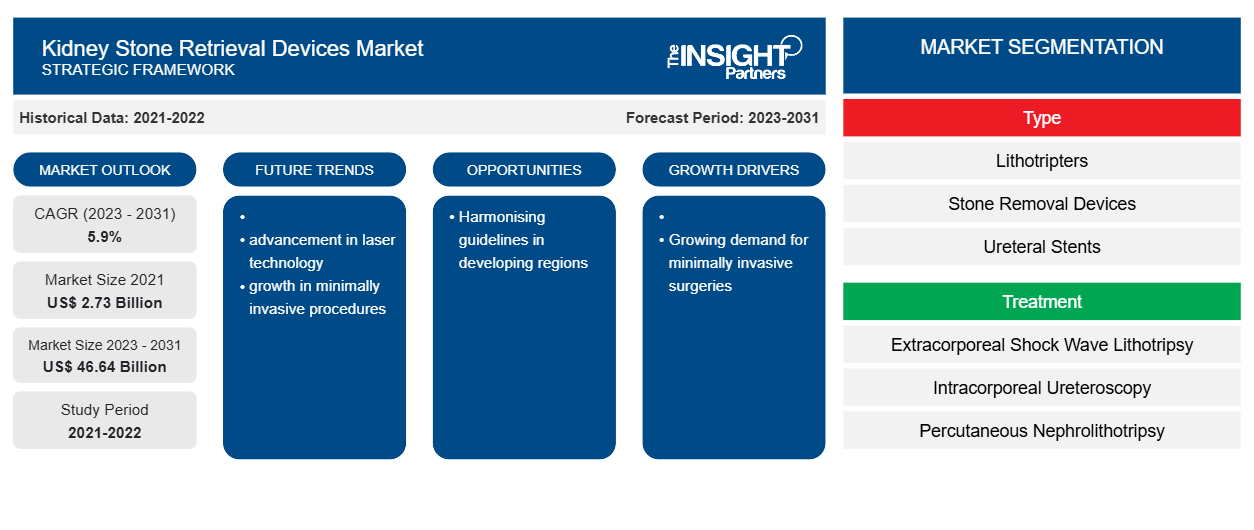Das Marktvolumen für Geräte zur Nierensteinentfernung wurde auf 2,73 Milliarden US-Dollar im Jahr 2021 und XX Milliarden US-Dollar im Jahr 2023 geschätzt und soll bis 2031 46,64 Milliarden US-Dollar erreichen; bis 2031 wird eine durchschnittliche jährliche Wachstumsrate von 5,9 % erwartet. Die Präferenz für robotergestützte Operationen bei Nierenerkrankungen wird voraussichtlich weiterhin ein wichtiger Trend auf dem Markt für Geräte zur Nierensteinentfernung bleiben.
Geräte zur Nierensteinentfernung Marktanalyse
Die Produkteinführungen katalysieren das Wachstum des Marktes für Geräte zur Nierensteinentfernung erheblich. Unternehmen konzentrieren sich stark auf die Entwicklung von Geräten, die zur Durchführung minimalinvasiver chirurgischer Eingriffe verwendet werden. So brachte Boston Scientific im Januar 2023 das LithoVue Empower Retrieval Deployment Device in den USA und Europa auf den Markt. Das Gerät wird zur Entfernung von Nierensteinen durch flexible Ureteroskopie (URS) verwendet und ist für die Verwendung mit dem LithoVue Single-Use Digital Flexible Ureteroscope und einem kompatiblen Nitinol-Entfernungskorb vorgesehen. Das Gerät ermöglicht den gleichzeitigen Betrieb eines Ureteroskops und eines Korbs. Die technologischen Fortschritte des Produkts vereinfachen die Verfahren und helfen beim Aufnehmen und Entfernen des Steins. Solche minimalinvasiven Verfahren werden häufig eingesetzt, um Nierensteine bei älteren Menschen zu entfernen. Die bei diesen Verfahren verwendeten Geräte verkürzen die für die Operation erforderliche Zeit und die Dauer des Krankenhausaufenthalts und ermöglichen eine schnelle Genesung.
Marktübersicht für Geräte zur Nierensteinentfernung
Der globale Markt für Geräte zur Nierensteinentfernung ist nach Regionen unterteilt in Nordamerika, Europa, Asien-Pazifik, Mittlerer Osten und Afrika sowie Süd- und Mittelamerika. Die Region Nordamerika hält den größten Marktanteil, während die Region Asien-Pazifik die am schnellsten wachsende Region ist. Das Wachstum in Nordamerika ist auf die zunehmende Häufigkeit von Nierensteinen in den Ländern, steigende Gesundheitsausgaben für chronische Nierenerkrankungen und zunehmende staatliche Unterstützung durch die Einführung von Richtlinien zur Behandlung von Nierensteinen zurückzuführen. Andererseits wird erwartet, dass der Mangel an Fachwissen, der für minimalinvasive Verfahren erforderlich ist, das Marktwachstum behindert.
Passen Sie diesen Bericht Ihren Anforderungen an
Sie erhalten kostenlos individuelle Anpassungen an jedem Bericht, einschließlich Teilen dieses Berichts oder einer Analyse auf Länderebene, eines Excel-Datenpakets sowie tolle Angebote und Rabatte für Start-ups und Universitäten.
-
Holen Sie sich die wichtigsten Markttrends aus diesem Bericht.Dieses KOSTENLOSE Beispiel umfasst eine Datenanalyse von Markttrends bis hin zu Schätzungen und Prognosen.
Markttreiber und Chancen für Geräte zur Nierensteinentfernung
Wachsende Nachfrage nach minimalinvasiven Eingriffen begünstigt den Markt
Im Laufe der Zeit hat die Prävalenz von Nierenerkrankungen stark zugenommen, was zu einer Zunahme chirurgischer Eingriffe geführt hat. Invasive chirurgische Eingriffe sind mit hohen Risikofaktoren verbunden und die Genesung der Patienten dauert länger. Diese Eingriffe bergen weltweit ein hohes Infektionsrisiko und eine hohe Komplikationsrate. Um die mit invasiven Eingriffen verbundenen Folgen zu überwinden, werden von medizinischem Fachpersonal minimalinvasive Eingriffe bevorzugt. Medizinisches Fachpersonal neigt aufgrund verschiedener Vorteile eher zu minimalinvasiven Eingriffen, wie z. B. kürzere Genesungsphasen, sehr geringe bis keine Komplikationen, hohe Erfolgsraten und Verkürzung der Eingriffsdauer. In den letzten Jahren ist die minimalinvasive Chirurgie zur Behandlung von Steinen der oberen Harnwege immer beliebter geworden. Die European Association of Urology empfiehlt sowohl die perkutane Nephrolithotomie (PCNL) als auch die retrograde intrarenale Chirurgie (RIRS) bei Steinen mit einem Durchmesser von weniger als 2 cm. Die PCNL ist die erste Wahl bei Steinen mit einem Durchmesser von mehr als 2 cm. Mit der Weiterentwicklung endoskopischer Instrumente und minimalinvasiver Technologie hat sich die traditionelle PCNL zu Mini-PCNL, Ultra-Mini-PCNL, Super-Mini-PCNL, Micro-PCNL und anderen minimalinvasiven Verfahren weiterentwickelt. Darüber hinaus führte eine Zunahme minimalinvasiver Verfahren zur Produkteinführung und Entwicklung spezieller Instrumente, die während der Operation helfen. Die positiven Ergebnisse minimalinvasiver Operationen haben die Neigung zu minimalinvasiven Nierensteinoperationen erhöht, da sich die Marktteilnehmer auf die Entwicklung und Einführung fortschrittlicher Produkte konzentrieren. percutaneous nephrolithotomy (PCNL) and retrograde intrarenal surgery (RIRS) for stones with a diameter less than 2 cm. PCNL is the first choice for stones with a diameter greater than 2 cm. With the advancement of endoscopic instruments and minimally invasive technology, traditional PCNL has evolved into Mini-PCNL, Ultra-mini PCNL, Super-mini PCNL, Micro-pcnl, and other minimally invasive procedures. Additionally, an increase in minimally invasive procedures led to product launches and development of specialized instruments that help during the surgery. The positive outcomes of minimally invasive surgeries have increased the inclination toward minimally invasive kidney stone surgeries as market players are focused on development and launch of advanced products.
Harmonisierung der Richtlinien zur Nierensteinentfernung in Entwicklungsregionen – eine Chance
Die Harmonisierung der Richtlinien für Nierensteinentfernungsverfahren wird voraussichtlich eine wichtige Chance für das Wachstum der globalen Marktteilnehmer darstellen. In Regionen wie dem asiatisch-pazifischen Raum und dem Nahen Osten werden Nierensteine durch offene/laparoskopische Pyelolithotomie- und Ureterolithotomieverfahren entfernt. In Ländern wie Korea, Japan und der Türkei gehört die endoskopische kombinierte intrarenale Chirurgie (ECIRS) zu den am häufigsten bevorzugten Verfahren, und in pädiatrischen Fällen ist die Stoßwellenlithotripsie (SWL) das Standardverfahren. Aufgrund von Faktoren wie mangelndem Bewusstsein für minimalinvasive Verfahren sowie dem sozialen, wirtschaftlichen und ethnischen Umfeld in den Ländern Asiens und des Nahen Ostens gibt es jedoch große Unterschiede in der klinischen Praxis von Nierensteinentfernungsverfahren. In einigen Ländern des asiatisch-pazifischen Raums gibt es eine begrenzte Präferenz für Verfahren wie RIRS, Ureterorenoskopie (URS) und PCNL. Die Vorteile dieser Verfahren werden wahrscheinlich die öffentliche Gesundheit verbessern und den Markt für Geräte zur Nierensteinentfernung ankurbeln. Um die Anzahl minimalinvasiver Eingriffe zu erhöhen, hat die Urological Association of Asia asiatische Richtlinien für alle urologischen Bereiche des Kontinents entwickelt. Die Richtlinien wurden mit Unterstützung von Expertenvertretern der American Urological Association und der European Association of Urology entwickelt. Die Entwicklung asiatischer Richtlinien wird sich daher an den Standards der American Urological Association und der European Association of Urology orientieren, da diese als Standard gelten. Die Einführung solcher einheitlicher Richtlinien soll den Prozess der Entwicklung von Nierenentnahmegeräten in den kommenden Jahren standardisieren.
Marktbericht zu Geräten zur Nierensteinentfernung – Segmentierungsanalyse
Wichtige Segmente, die zur Ableitung der Marktanalyse für Geräte zur Nierensteinentfernung beigetragen haben, sind Typ, Behandlung und Endbenutzer.
- Der Markt für Geräte zur Nierensteinentfernung ist nach Typ in Lithotripter, Steinentfernungsgeräte, Ureterstents und Ureterorenoskope unterteilt. Das Segment der Lithotripter hatte im Jahr 2023 den größten Marktanteil.
- Nach Behandlung ist der Markt in extrakorporale Stoßwellenlithotripsie (ESWL), intrakorporale Ureterorenoskopie und perkutane Nephrolithotripsie segmentiert. Das Segment der extrakorporalen Stoßwellenlithotripsie (ESWL) hatte im Jahr 2023 den größten Marktanteil.
- In Bezug auf den Endverbraucher ist der Markt in Krankenhäuser und Kliniken, Fachkliniken und ambulante Operationszentren segmentiert. Das Segment Krankenhäuser und Kliniken dominierte den Markt im Jahr 2023.
Marktanteilsanalyse für Geräte zur Nierensteinentfernung nach geografischer Lage
Der geografische Umfang des Marktberichts für Geräte zur Nierensteinentfernung ist hauptsächlich in fünf Regionen unterteilt: Nordamerika, Asien-Pazifik, Europa, Naher Osten und Afrika sowie Südamerika/Süd- und Mittelamerika. Nordamerika ist der größte Markt für Geräte zur Nierensteinentfernung, wobei die USA den größten Marktanteil halten, gefolgt von Kanada. Der Markt für Geräte zur Nierensteinentfernung wird voraussichtlich wachsen, da die Zahl der Nierensteine in den Ländern zunimmt, die Gesundheitsausgaben für chronische Nierenerkrankungen steigen und die staatliche Unterstützung durch die Einführung von Richtlinien zur Behandlung von Nierensteinen zunimmt. Darüber hinaus wird erwartet, dass der wachsende Medizintourismus in Mexiko, der Nierensteinbehandlungen zu einem niedrigeren Preis anbietet, Wachstumschancen für das Wachstum des Marktes schafft. Der Asien-Pazifik-Raum wird in den kommenden Jahren voraussichtlich die höchste durchschnittliche jährliche Wachstumsrate aufweisen.
Regionale Einblicke in den Markt für Geräte zur Nierensteinentfernung
Die regionalen Trends und Faktoren, die den Markt für Geräte zur Nierensteinentfernung während des Prognosezeitraums beeinflussen, wurden von den Analysten von Insight Partners ausführlich erläutert. In diesem Abschnitt werden auch die Marktsegmente und die Geografie von Geräten zur Nierensteinentfernung in Nordamerika, Europa, im asiatisch-pazifischen Raum, im Nahen Osten und Afrika sowie in Süd- und Mittelamerika erörtert.

- Erhalten Sie regionale Daten zum Markt für Geräte zur Nierensteinentfernung
Umfang des Marktberichts zu Geräten zur Nierensteinentfernung
| Berichtsattribut | Details |
|---|---|
| Marktgröße im Jahr 2021 | 2,73 Milliarden US-Dollar |
| Marktgröße bis 2031 | 46,64 Milliarden US-Dollar |
| Globale CAGR (2023 - 2031) | 5,9 % |
| Historische Daten | 2021-2022 |
| Prognosezeitraum | 2023–2031 |
| Abgedeckte Segmente |
Nach Typ
|
| Abgedeckte Regionen und Länder |
Nordamerika
|
| Marktführer und wichtige Unternehmensprofile |
|
Marktteilnehmerdichte für Geräte zur Nierensteinentfernung: Auswirkungen auf die Geschäftsdynamik verstehen
Der Markt für Geräte zur Nierensteinentfernung wächst rasant. Dies wird durch die steigende Nachfrage der Endnutzer aufgrund von Faktoren wie sich entwickelnden Verbraucherpräferenzen, technologischen Fortschritten und einem größeren Bewusstsein für die Vorteile des Produkts vorangetrieben. Mit der steigenden Nachfrage erweitern Unternehmen ihr Angebot, entwickeln Innovationen, um die Bedürfnisse der Verbraucher zu erfüllen, und nutzen neue Trends, was das Marktwachstum weiter ankurbelt.
Die Marktteilnehmerdichte bezieht sich auf die Verteilung der Firmen oder Unternehmen, die in einem bestimmten Markt oder einer bestimmten Branche tätig sind. Sie gibt an, wie viele Wettbewerber (Marktteilnehmer) in einem bestimmten Marktraum im Verhältnis zu seiner Größe oder seinem gesamten Marktwert präsent sind.
Die wichtigsten auf dem Markt für Geräte zur Nierensteinentfernung tätigen Unternehmen sind:
- Boston Scientific ist eine gemeinnützige Organisation, die sich auf die Förderung von Wissenschaft und Technologie spezialisiert hat. Sie ist die erste in den USA und hat 19
- Olympus Corporation
- BD
- Kochen
- Coloplast Gruppe
- Dornier MedtechTactus
Haftungsausschluss : Die oben aufgeführten Unternehmen sind nicht in einer bestimmten Reihenfolge aufgeführt.

- Überblick über die wichtigsten Akteure auf dem Markt für Geräte zur Nierensteinentfernung
Marktnachrichten und aktuelle Entwicklungen zu Geräten zur Nierensteinentfernung
Der Markt für Geräte zur Nierensteinentfernung wird durch die Erhebung qualitativer und quantitativer Daten nach Primär- und Sekundärforschung bewertet, die wichtige Unternehmensveröffentlichungen, Verbandsdaten und Datenbanken umfasst. Im Folgenden finden Sie eine Liste der Entwicklungen auf dem Markt für Sprach- und Sprechstörungen sowie Strategien:
- Im Februar 2023 gab Ethicon, ein MedTech-Unternehmen von Johnson & Johnson, bekannt, dass sich der erste Patient einem robotergestützten Eingriff zur Entfernung von Nierensteinen mithilfe der MONARCH-Plattform für Urologie unterzogen hatte. Der Eingriff wurde von UCI Health, dem klinischen Unternehmen der University of California, Irvine, im Rahmen einer klinischen Studie erfolgreich durchgeführt. Die MONARCH-Plattform für Urologie wurde verwendet, um den ersten robotergestützten elektromagnetisch (EM) geführten perkutanen Zugang und die miniperkutane Nephrolithotomie (PCNL) durchzuführen. (Quelle: Johnson & Johnson, Pressemitteilung, 2023)
Geräte zur Nierensteinentfernung – Marktbericht – Abdeckung und Ergebnisse
Der Bericht „Marktgröße und Prognose für Geräte zur Nierensteinentfernung (2021–2031)“ bietet eine detaillierte Analyse des Marktes, die die folgenden Bereiche abdeckt:
- Marktgröße und Prognose auf globaler, regionaler und Länderebene für alle wichtigen Marktsegmente, die im Rahmen des Projekts abgedeckt sind
- Marktdynamik wie Treiber, Beschränkungen und wichtige Chancen
- Wichtige Zukunftstrends
- Detaillierte PEST/Porters Five Forces- und SWOT-Analyse
- Globale und regionale Marktanalyse mit wichtigen Markttrends, wichtigen Akteuren, Vorschriften und aktuellen Marktentwicklungen
- Branchenlandschaft und Wettbewerbsanalyse, einschließlich Marktkonzentration, Heatmap-Analyse, prominenten Akteuren und aktuellen Entwicklungen
- Detaillierte Firmenprofile
- Historische Analyse (2 Jahre), Basisjahr, Prognose (7 Jahre) mit CAGR
- PEST- und SWOT-Analyse
- Marktgröße Wert/Volumen – Global, Regional, Land
- Branchen- und Wettbewerbslandschaft
- Excel-Datensatz
Aktuelle Berichte
Erfahrungsberichte
Grund zum Kauf
- Fundierte Entscheidungsfindung
- Marktdynamik verstehen
- Wettbewerbsanalyse
- Kundeneinblicke
- Marktprognosen
- Risikominimierung
- Strategische Planung
- Investitionsbegründung
- Identifizierung neuer Märkte
- Verbesserung von Marketingstrategien
- Steigerung der Betriebseffizienz
- Anpassung an regulatorische Trends























 Kostenlose Probe anfordern für - Markt für Geräte zur Nierensteinentfernung
Kostenlose Probe anfordern für - Markt für Geräte zur Nierensteinentfernung